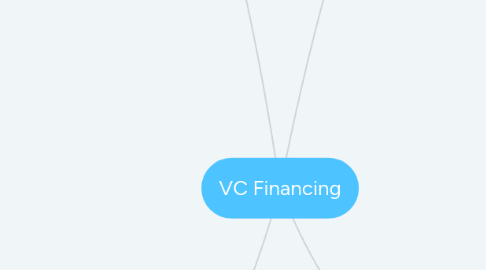
1. 04 Use of VC Financing
1.1. Why??
1.1.1. Information asymmetry
1.1.1.1. effort cannot be foreseen
1.1.1.2. effort cannot be observed
1.1.2. If allow MH and AS
1.1.2.1. complete contract is impossible
1.1.3. Characteristic
1.1.3.1. firm with large intangible asset
1.1.3.2. performance hard to assess
1.1.3.3. high tech firm
1.1.3.4. heavy rely on R&D
1.1.3.5. State of art-technology
1.1.3.5.1. hard to commercialized
1.1.4. Enterpreneurs
1.1.4.1. incentive to use high volaties strategy
1.1.4.1.1. not their own money
1.2. Solution
1.2.1. Scrutinize(before invest)
1.2.1.1. screening
1.2.2. Monitor(after Invest)
1.3. What VC do to filter the asymmetry info(Tools)
1.3.1. Stage financing
1.3.1.1. keep entrepreneur on tight leash
1.3.1.2. reduce looses from bad decision
1.3.1.3. High info asymmetry, High monitoring
1.3.1.3.1. highest marginal return
1.3.1.4. Receive less money per round
1.3.1.4.1. as firm doing good
1.3.2. Syndicating
1.3.2.1. Second opinion hypothesis
1.3.2.2. diversify firm specific risk
1.3.2.3. In early round - only with similar experience VC
1.3.2.3.1. Senior with Senior
1.3.2.3.2. Young with Young
1.3.3. Compensation
1.3.3.1. Control Mechanism
1.3.3.1.1. Equity Base
1.3.3.1.2. Stock-option
1.3.3.1.3. Vesting Period
1.3.3.2. Assumption
1.3.3.2.1. Moral Hazard
1.3.3.2.2. Adverse Selection
1.3.3.3. Outcome
1.3.3.3.1. Incentive Alignment between Principal and Agent
1.3.4. Security Design
1.3.4.1. VC commonly receive Convertible preference share
1.3.4.1.1. Control via Common stock is costly
1.3.4.1.2. Convertible share control via term that are renegotiable
1.3.4.1.3. Hellman 2006
1.4. Payoff or Venture Capitalist
1.4.1. Bottomlin
1.4.1.1. Need to liquid to realized return
1.4.1.2. IPO is the most profit
1.4.2. The Relationship Between Growth of VC and level of IPO market
1.4.2.1. Rationale
1.4.2.1.1. 1. Probability to exit via IPO is low
1.4.2.1.2. 2. Quiet IPO(downbeat) = low return for VC
1.4.2.2. Implication
1.4.2.2.1. This relationship is the explanation that VC is only the US phenomenal
2. 01 What is VC?
2.1. Pool of money for High risk investment
2.2. Can be view as Intermediary in Capital market(similar to Bank)
2.3. Subset of Corporate finance but not the same as mainstream corporate financing
2.4. It is a US phenominemom
3. 03 Source of VC financing
3.1. Capital Gain Tax
3.1.1. Pension fund(tax-exempt investor) Influence from supply side (not quite true)
3.2. Incentive Compensation
3.2.1. Older and Larger fund
3.2.1.1. sensitive to performance
3.2.2. New venture
3.2.2.1. Learning model
3.2.2.1.1. work hard for Reputation
3.3. Covenant and Restriction
3.3.1. Limit conflict Between LP and GP
3.3.2. No Refinanced, Fail is Fail
3.3.3. Prohibit from raised more fund
3.3.3.1. However, the greater the venture capitalist the greater the power
3.3.3.1.1. fund establish on a bullish year
3.3.3.1.2. fund with no investment manager
3.3.3.1.3. fund that GP enjoy higher compensation
3.3.4. Prohibit to invest in other area of expertise
3.3.5. Employee turn to Entrepreneurs(tax incentive) Influence from (demand side)
3.3.6. Prohibit to invest in the company that earlier fund had invested
3.3.6.1. Prevent under the carpet deal
4. 02 Mainstream Corporate Finance(blue) vs VC(red)
4.1. Liquidity
4.1.1. Liquidity
4.1.1.1. Stock market
4.1.2. Illiquidity
4.1.2.1. No market to trade
4.2. Monitoring by SH
4.2.1. Passive /Indirest
4.2.1.1. SEO, PP
4.2.2. Active, Direct
4.2.2.1. send in BOD member
4.3. Role of Market discipline
4.3.1. High
4.3.1.1. In Corporate, company pay dividend to reduce agency cost and force the management to get fund from capital market which required to be scrutinized by Bank and underwriter
4.3.2. Low
4.3.2.1. Not much control from capital market
4.4. Access to Capital
4.4.1. Competitive and anonymous
4.4.2. Early Stage
4.4.2.1. limited to financiers with highly specialized skills
4.4.3. Later Stage
4.4.3.1. more competitive but active monitoring skill required
4.5. Asset Specificity
4.5.1. Generally Low
4.5.2. Non-deployable / Highly specialized asset
4.6. Project valuation
4.6.1. Varietyof technique
4.6.1.1. DCF, Multiple, sensitivity
4.6.2. Limited technique
4.6.2.1. sensitivity analysis
4.7. Investment Decision
4.7.1. Single stage
4.7.2. Multiple Stage
4.7.2.1. seed , Early, A, B,C, Pre-IPO, IPO
4.8. Information avalibility
4.8.1. Private, Rare, mandatory disclosure
4.8.2. Private info, widespread and hard to reveal; close monitoring required
